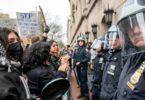Patrick Gathara
At the end of January 2018, Kenya’s veteran opposition leader Raila Odinga took the oath of office as the self-described “people’s president”, barely three months after boycotting a repeat election called following the annulment by the courts of the initial poll in August.
His rival, Uhuru Kenyatta, the incumbent president, had been declared duly re-elected, and Odinga had threatened to hold a parallel inauguration ceremony for himself, then tried to back out, before being pushed by the younger and more militant fringe of his coalition into doing it. However, even then, he could not bring himself to take the oath as prescribed in the constitution. He seemed to know what the limits were and would go no further.
That event neatly illustrates one of the challenges facing Kenya today and the reason why the current face-off between Odinga and Kenyatta’s successor, his former deputy and BFF-turned-foe William Ruto, are so profoundly disturbing and frightening for many Kenyans. Elite contestations for power and opportunities for extraction in Kenya have had a fairly predictable logic and pattern – one could say, as Joe Kobuthi of The Elephant has written, that there have always been “unwritten rules of engagement govern their game of thrones”.
Both politicians and the common Kenyans who must endure their violent predation have had an idea of where the red lines that limit how far they can go are. The elite who govern Kenya via a series of crises, each fomented for the sake of gaining a seat at the eating table, required such rules to keep the whole thing from imploding. It is these rules that have created what Charles Obbo describes in The EastAfrican as “the amorality – and even immorality – of [Kenyan] politicians [that] … has helped them avoid civil wars and the do-or-die politics that have ruined many an African country”. Street protests have, for example, been an effective way for the opposition to demand reform and their share of the loot from recalcitrant regimes. It is a tactic that seeks not just to demonstrate public backing for the opposition’s cause, but also to provoke the state into an overreaction that would inevitably position it as the enemy of constitutionalism and democracy. And it almost always works, with the state happy to constantly reprise its role as the purveyor of colonial terror in a bid to remind the natives of their place. Following periods of intense contestations during which death, maiming and destruction on a scale acceptable to the elite occurs, the politicians cut a deal before it all gets out of hand. As Kobuthi notes, “internal squabbles [between elites], which have regularly led to episodic violence in the country, they have been mediated through elite ‘handshakes’ – essentially boardroom deals”.
However, over the last few years, as the independence generation of politicians has left the stage, their successors have increasingly seemed unwilling to respect the rules of the game. And this is what is driving much of the angst around the current protests and the state’s reaction. While it may look like the usual intra-elite quarrel over power, it is in many ways a subversion of the game. When the demonstrations were called last year in the wake of Ruto’s elections, they represented a flipping of the script. Rather than a way to rein in an administration going rogue, they were rightly perceived by many as an attempt by Odinga, yet again the losing presidential candidate, to hold the country to ransom despite failure to produce any credible proof that the election had actually been stolen from him. The initially muted public response to his calls for demonstrations spoke to this as does the fact that barely a year later, Odinga appears to have completely abandoned the claims of rigging and settled for the more potent complaints about Ruto’s stewardship of the economy and inability to tame rising prices. Still, his weaponisation of street demos for purely selfish ends has been unsettling. On the other hand, the state’s response to the protests also indicates the changing of the rules. In the past, elites have preferred the bodies and property of common Kenyans as the battleground for settling their disputes, and have largely avoided targeting each other personally. In July 2008, for example, during a heated debate, a cabinet minister was caught on camera inviting a rival MP to “bring his people” for an all-out battle to settle the issue, suggesting his group had already slaughtered between 600 and 1,000 of them.
In fact, protecting each other, while murdering and displacing each other’s followers has been a running theme of Kenya’s post-independence politics. Just as Jomo Kenyatta, the first president of Kenya, protected the white settlers he had claimed to fight from the appropriation of their stolen farms, his successor Daniel Moi protected the Kenyatta family’s own corrupt acquisitions. Then Mwai Kibaki, the third president, and Odinga protected Moi’s corrupt fortune and Uhuru Kenyatta (Jomo’s son) protected Kibaki’s. Ruto, who accuses his predecessor of financing the ongoing protests, has however seemed less inclined to continue in that tradition, at least for now. In March, with his government’s complicity, gangs of youths invaded and vandalised a farm belonging to the Kenyatta family. On the same day, another group attacked the premises of a company belonging to Odinga. Last week, the former president had to rush to his son’s aid after the latter’s house was raided by police. Such personalisation of political violence is not the done thing within the small incestuous mafia for whom politics is not personal, it is just business. Within that context, the violence unleashed by Ruto on protesters takes on a new and more sinister hue. Elected on a populist platform of making Kenya work for its poorest, his administration has initially shown remarkable restraint when compared with previous regimes. Perhaps that was simply because the initial protests had little traction. But as they morphed into a forum for expressing much more widely held sentiments about the cost of living, it was predictable that a crackdown would come. When it arrived, however, its ferocity and brutality caught many by surprise.
Egged on by his own lunatic fringe, which includes his deputy, Rigathi Gachagua, and the likes of Cabinet Minister Moses Kuria, whom even the Americans seem to consider too extreme, Ruto flooded the streets of the capital and other major cities with police, seemingly loosened from all restraint. Opposition politicians were abducted and kept incommunicado, many have gone into hiding, protesters and bystanders have been shot and beaten, tear gas used on homes and children, and hundreds, including opposition bloggers, arrested. Nobody knows how far Ruto is willing to go, perhaps least of all, he himself and his band of rogues. There does not seem to be much scope for or interest in a deal, neither within the shell-shocked opposition nor the chest-thumping regime. There are increasing fears of a rebirth of the Daniel Moi dictatorship, an eventuality that many believed was fading as a real option despite the efforts of his successors. Odinga’s Azimio la Umoja coalition has called off this week’s protests, but Kenyans still wait to find out what the new red lines will be, and what the new rules of the game are.







